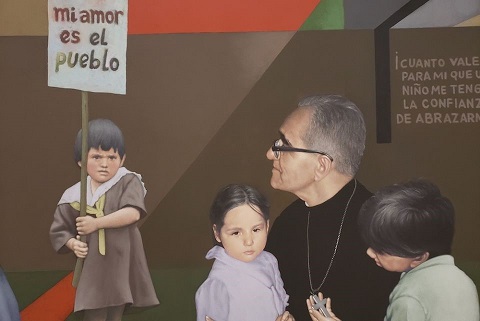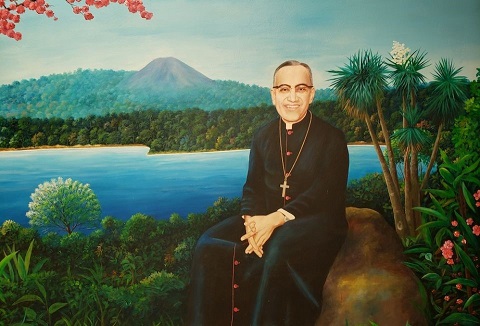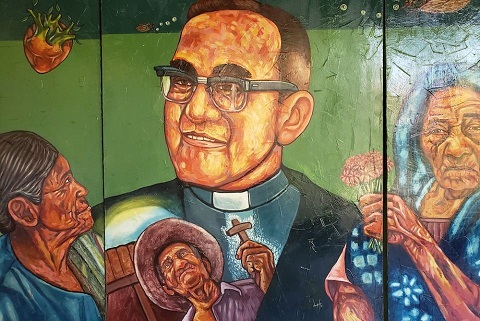40 YEARS ANNIVERSARY, DEATH OF ST OSCAR ROMERO. LEGACIES.

Painting by Rafael Valera at San Salvador international airport.
40th anniversary of Óscar Romero's assassination, March 24.
Excerpts from an article by Chris Herlinger, Global Sisters Report.
In a country where Romero's visage is seemingly everywhere — in churches, on street corners, in shops and living rooms — one question hovers at the sidelines: which Óscar Romero is being honored? The saint? The humble priest? The martyred Catholic? A man entombed in history at a particular time and place, or a living example for a country still struggling with the legacy and after-effects of a decade-long civil war?
Tellingly, in between visits to those neighborhoods, I kept returning to a point of pilgrimage: the grounds of the Hospital de la Divina Providencia, where Romero lived and where he celebrated his last Mass on March 24, 1980. The hospital is run by the Missionary Carmelites of St. Teresa.
One of those I spoke to was Carmelite Fr. Paul Henson, visiting from Los Angeles. We met just a few yards from the altar where Romero was felled by a gunman who, from outside the chapel, shot the cleric with a rifle.
Henson finds Romero's legacy continuing in the ministry of Pope Francis — a ministry dedicated to facing "the suffering of the poor," such as those at the U.S.-Mexican border. "His [Romero's] theology was always "God first,' " Henson said, leading him to reflect and question whether in the current crisis, borders "are absolute."

Portrait at the entry to the house where Oscar Romero lived
A few days later, in the same chapel, I met Carmelite Sr. María Julia García, the current hospital administrator. She was 28 when Romero was assassinated and saw him occasionally. She recalls a modest and quiet man who sought peace with an eye for practical solutions. With Romero's assassination, "people felt lonely and unprotected because nobody would stand up for them."
"He lived the word of God and made it come alive," she said, adding that Romero, like Jesus, offered his life as a sacrifice for those he loved. But at the same time, García believes Romero did not "fly a political flag. His flag was the Gospel."
At a moment when people in El Salvador were being killed "for nothing," Romero's prophetic stance against violence — and his specific call the day before his assassination that those in the military stop their killing — is what ultimately caused his death, García said.
"He was like a stone in the shoe," she said, noting that even today not all Salvadoran Catholics believe Romero is a saint.
"But people with a social consciousness believe he was a saint," she said.
Even so, those who have resisted the adoration of Romero still have the power to provoke.
Followers of the late right-wing political leader Roberto D'Aubuisson, who a United Nations truth commission named as the one who ordered Romero's assassination, "still believe he was in the right to order the killing," They still believe Romero was a terrorist.Some on the right said the Salvadoran left wanted Romero killed "so they could have a saint, a martyr."
When news spread of Romero's assassination, celebratory fireworks went off in some of San Salvador's wealthy neighborhoods. The wealthy called Romero a communist who, they believed, should have "tended to pastoral concerns.
It is likely that the debate over Romero's legacy will never be fully settled.
He is a saint. He made the ordinary extraordinary. He spoke the truth, and with that, changed lives and made a social transformation.

Painting at Suchitot Museum, El Salvador